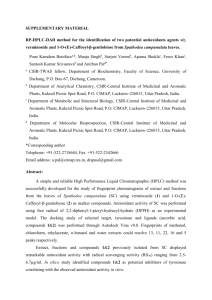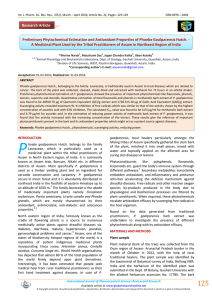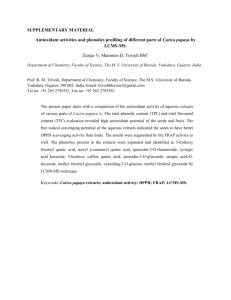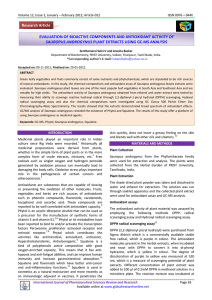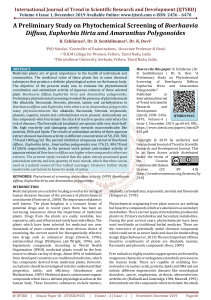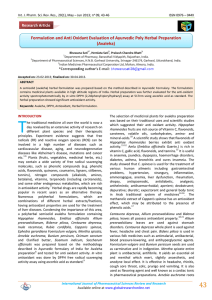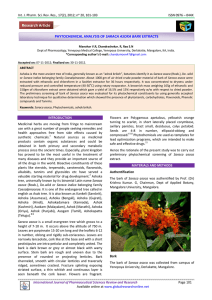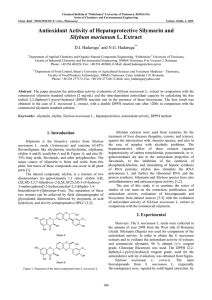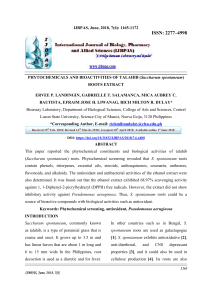Document 13310206
advertisement
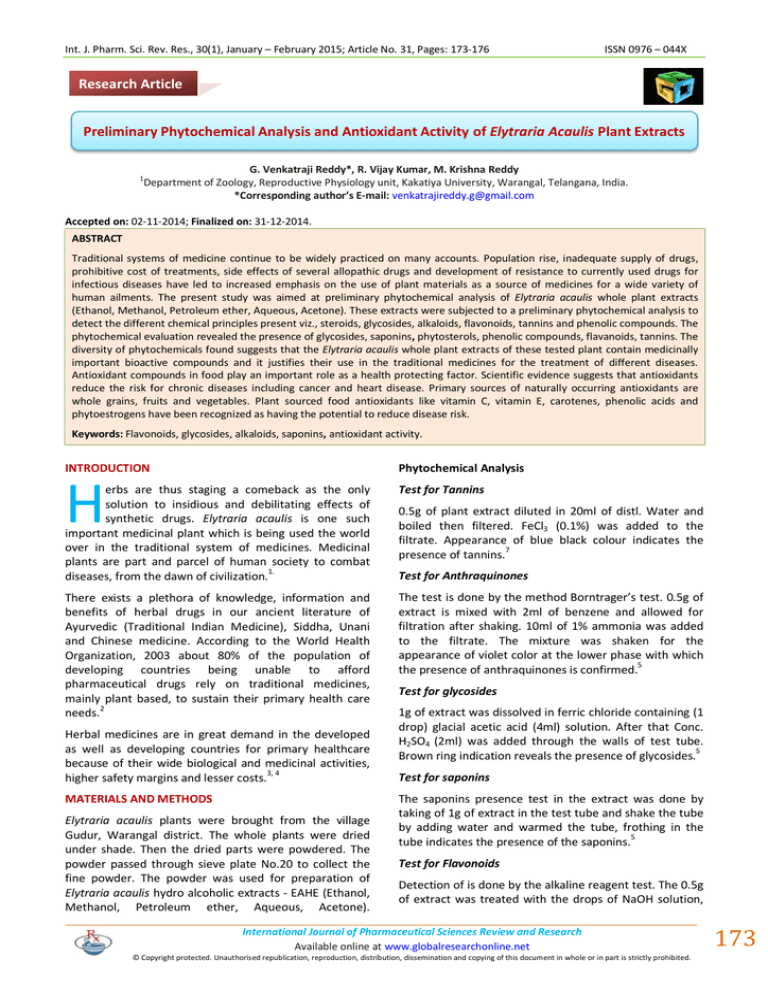
Int. J. Pharm. Sci. Rev. Res., 30(1), January – February 2015; Article No. 31, Pages: 173-176 ISSN 0976 – 044X Research Article Preliminary Phytochemical Analysis and Antioxidant Activity of Elytraria Acaulis Plant Extracts 1 G. Venkatraji Reddy*, R. Vijay Kumar, M. Krishna Reddy Department of Zoology, Reproductive Physiology unit, Kakatiya University, Warangal, Telangana, India. *Corresponding author’s E-mail: venkatrajireddy.g@gmail.com Accepted on: 02-11-2014; Finalized on: 31-12-2014. ABSTRACT Traditional systems of medicine continue to be widely practiced on many accounts. Population rise, inadequate supply of drugs, prohibitive cost of treatments, side effects of several allopathic drugs and development of resistance to currently used drugs for infectious diseases have led to increased emphasis on the use of plant materials as a source of medicines for a wide variety of human ailments. The present study was aimed at preliminary phytochemical analysis of Elytraria acaulis whole plant extracts (Ethanol, Methanol, Petroleum ether, Aqueous, Acetone). These extracts were subjected to a preliminary phytochemical analysis to detect the different chemical principles present viz., steroids, glycosides, alkaloids, flavonoids, tannins and phenolic compounds. The phytochemical evaluation revealed the presence of glycosides, saponins, phytosterols, phenolic compounds, flavanoids, tannins. The diversity of phytochemicals found suggests that the Elytraria acaulis whole plant extracts of these tested plant contain medicinally important bioactive compounds and it justifies their use in the traditional medicines for the treatment of different diseases. Antioxidant compounds in food play an important role as a health protecting factor. Scientific evidence suggests that antioxidants reduce the risk for chronic diseases including cancer and heart disease. Primary sources of naturally occurring antioxidants are whole grains, fruits and vegetables. Plant sourced food antioxidants like vitamin C, vitamin E, carotenes, phenolic acids and phytoestrogens have been recognized as having the potential to reduce disease risk. Keywords: Flavonoids, glycosides, alkaloids, saponins, antioxidant activity. INTRODUCTION Phytochemical Analysis H erbs are thus staging a comeback as the only solution to insidious and debilitating effects of synthetic drugs. Elytraria acaulis is one such important medicinal plant which is being used the world over in the traditional system of medicines. Medicinal plants are part and parcel of human society to combat diseases, from the dawn of civilization.1. Test for Tannins There exists a plethora of knowledge, information and benefits of herbal drugs in our ancient literature of Ayurvedic (Traditional Indian Medicine), Siddha, Unani and Chinese medicine. According to the World Health Organization, 2003 about 80% of the population of developing countries being unable to afford pharmaceutical drugs rely on traditional medicines, mainly plant based, to sustain their primary health care needs.2 The test is done by the method Borntrager’s test. 0.5g of extract is mixed with 2ml of benzene and allowed for filtration after shaking. 10ml of 1% ammonia was added to the filtrate. The mixture was shaken for the appearance of violet color at the lower phase with which the presence of anthraquinones is confirmed.5 Herbal medicines are in great demand in the developed as well as developing countries for primary healthcare because of their wide biological and medicinal activities, higher safety margins and lesser costs.3, 4 MATERIALS AND METHODS Elytraria acaulis plants were brought from the village Gudur, Warangal district. The whole plants were dried under shade. Then the dried parts were powdered. The powder passed through sieve plate No.20 to collect the fine powder. The powder was used for preparation of Elytraria acaulis hydro alcoholic extracts - EAHE (Ethanol, Methanol, Petroleum ether, Aqueous, Acetone). 0.5g of plant extract diluted in 20ml of distl. Water and boiled then filtered. FeCl3 (0.1%) was added to the filtrate. Appearance of blue black colour indicates the presence of tannins.7 Test for Anthraquinones Test for glycosides 1g of extract was dissolved in ferric chloride containing (1 drop) glacial acetic acid (4ml) solution. After that Conc. H2SO4 (2ml) was added through the walls of test tube. Brown ring indication reveals the presence of glycosides.5 Test for saponins The saponins presence test in the extract was done by taking of 1g of extract in the test tube and shake the tube by adding water and warmed the tube, frothing in the 5 tube indicates the presence of the saponins. Test for Flavonoids Detection of is done by the alkaline reagent test. The 0.5g of extract was treated with the drops of NaOH solution, International Journal of Pharmaceutical Sciences Review and Research Available online at www.globalresearchonline.net © Copyright protected. Unauthorised republication, reproduction, distribution, dissemination and copying of this document in whole or in part is strictly prohibited. 173 © Copyright pro Int. J. Pharm. Sci. Rev. Res., 30(1), January – February 2015; Article No. 31, Pages: 173-176 which forms of intense yellow colour and becomes colourless by the addition of dilute acid, which denotes the flavanoid presence.8 Another test is by the adding of few drops of 1% aluminium solution to the filtrate of extract (0.5g) from 80% ethanol and petroleum ether, which results the formation of yellow colour. The colour indicates the presence of the flavonoids.10 Another test was done by the method of Shinoda test: the Hcl added to the extract (0.5g) and Mg chip, which gives the orange/red/red crimson/ crimson magenta colour, by indicating the presence of flavonoids.6 Test for steroids Extract (0.5g) was dissolved in 2ml of chloroform and 2ml of conc. H2SO4 was added to it, which gives green to 9 bluish colour by indicating the steroids in it. Test of Phenols The extract (0.5g) was added with 3 to 4ml of FeCl3. The formation of bluish black colour indicates the presence of phenols in the extract.6 Test for alkaloids The test is performed by the Hager’s test. 1g of extract is filtered from the diluted hydrochloric acid and filtered. The filtrate is then added by the saturated picric acid. Alkaloids presence gives yellow colour precipitate.6 Antioxidant activity Principle DPPH antioxidant in vitro assay is based on the ability of test substance to decolorize DPPH, a stable free radical. DPPH has an odd electron, which is responsible for absorbance at 517 nm and also for visible purple color. When DPPH accepts an electron donated by Antioxidant, DPPH get colorized which is quantitatively measured by spectrophotometer. Procedure ISSN 0976 – 044X RESULTS AND DISCUSSION Phytochemical analysis conducted on the plant extracts revealed the presence of constituents which are known to exhibit medicinal as well as physiological activities 16 (Table 1). The plant extracts were also revealed to contain saponins which are known to produce inhibitory effect on inflammation.18 Flavonoids are hydroxylated phenolic substances known to be synthesized by plants in response to microbial infection and they have been found to be antimicrobial substances against wide array of microorganisms in vitro. Their activity is probably due to their ability to complex with extracellular and soluble 17 proteins and to complex with bacterial cell wall. The DPPH free radicals were inhibited by the extract (EAHE) in the DPPH free radical scavenging activity. The inhibition of the radicals was increased as the concentration of EAHE increased. The inhibition was comparable to the Ascorbic acid. The IC50 is the value at which the 50 % inhibition of the free radicals is observed. The Inhibited Concentration (IC50) of EAHE was 59.38 (µg/ml), whereas the IC50 value of Ascorbic acid is 51.50 (µg/ml). The table -2 and graph-1 shows the comparison of antioxidant activity of EAHE, Ascorbic acid. The freshly prepared DPPH solution looks in deep purple colour at 517 nm. The colour loses its darkness to fade if the solution contains the antioxidants.12 The EAHE added DPPH solution was observed in fading the intensity of colour. The intensity reduced as the concentration of the EAHE was increasing. The standard antioxidant ascorbic acid also showed its scavenging activity against DPPH radicals. The IC50 is the amount of the antioxidant in concentration at which the EAHE or Ascorbic acid can inhibit the DPPH concentration by 50%. The IC50 values of EAHE and Ascorbic acid are 56.21(µg/ml) and 49.63(µg/ml). It was proved that the presence of phytochemicals like tannins8, phenols, flavoniods13 may possess the free radical scavenging activity.14 CONCLUSION The antioxidant activity of extract was estimated by using DPPH (2, 2 - diphenyl – 1- picrylhydrazyl) assay. DPPH was used as free radical and ascorbic acid used as standard to assess the inhibition activity. 2 ml of extract/ascorbic acid of various concentrations (10-100µg/ml) was added to 2 ml of DPPH (100 µm) in methanol. Then all test tubes were incubated for 30 minutes at room temperature. Using corresponding blank (methanol) and DPPH as control the absorbance was taken at 517 nm by UV – Visible spectrophotometer.11 The experiment was performed triplicate. The IC50 (half maximal inhibitory concentration) value is the concentration of the sample, required to inhibit 50% DPPH free radicals. The scavenging activity was calculated by following principle. (%) = × 100 Analysis of the Elytraria acaulis whole plant hydro alcholic extracts revealed the presence of phytochemicals such as phenols, tannins, flavonoids, saponins, glycosides, steroids and alkaloids. The phenolic compounds are one of the largest and most ubiquitous groups of plant metabolites. They possess biological properties such as antiapoptosis, antiaging, anticarcinogen, antiinflammation, antiatherosclerosis, cardiovascular protection and improvement of endothelial function, as well as inhibition of angiogenesis and cell proliferation activities. Steroids are very important compounds especially due to their relationship with compounds such as sex hormones. The antioxidant properties of medicinal plants which are rich in phenolic compounds. Natural antioxidant mainly come from plants in the form of phenolic compounds such as flavonoid, phenolic acids, International Journal of Pharmaceutical Sciences Review and Research Available online at www.globalresearchonline.net © Copyright protected. Unauthorised republication, reproduction, distribution, dissemination and copying of this document in whole or in part is strictly prohibited. 174 © Copyright pro Int. J. Pharm. Sci. Rev. Res., 30(1), January – February 2015; Article No. 31, Pages: 173-176 tocopherols etc. Tannins bind to proline rich protein and interfere with protein synthesis. The results obtained in this study thus suggest the identified phytochemical compounds may be the bioactive constituents and these plants are proving to be an increasingly valuable reservoir of bioactive compounds of substantial medicinal merit. REFERENCES 1. Bandyopadhyay U, Biswas K, Chattopadhyay I, Banerjee RK, Biological activities and medicinal properties of neem (Azadirachta indica), Currnt Sci., 82, 2002, 1336-1345. 2. Goyal BR, Goyal RK, Mehta AA, Phyto-Pharmacognosy of Archyranthes aspera: A Review. Pharmacog Rev., 2, 2008, 1-1. 3. Cragg GM, Newman DJ, Sander KM, Natural products in drug discovery and development. J Nat Prod., 60, 1997, 5260. Table 1: Phytochemical Analysis Phytochemicals Extracts ISSN 0976 – 044X Ethanolic Methanolic Pet. ether Aqueous Acetone Tannins - - - - - Anthraquinones - + - - - 4. Padma TV, India Ayurveda, Nature., 2005, 436-486. Glycosides + - + - + 5. Saponins - - - - - Flavonoids + + + + - Steroids - - + - - Prabhjith Kaur, Bikram Singh, Subodh Kumar, Satwinderjeet kaur, In vitro evaluation of free radical scavenging activity of Rubia cordifolia L. Journal of Chinese Clinical medicine, 5, 2008, 278-284. Phenols + + + + + 6. Alkaloids + - + + - Prashanth Tiwari, Bimlesh Kumar, Mandeep Kaur, Gurpreet Kaur, Harleen Kaur, Phytochemical screening and Extraction: A review, Internationale Pharmacetica Sciencia, 1, 2011, 98-106. 7. Sobia Nisa, Yamin Bibi, Abdul Waheed, Muhammad Zia, Sadia Sarwar, Sabbir Ahmed and Fayyaz Chaudary M, Evaluation of anticancer activity of Debregeasia salcifoila extract against estrogen receptor positive cell line, African Journal of Biotechnology, 6, 2011, 990-995. 8. Sani Ali Audu, Ilyas Mohammed, Haruna Abdul Kaita, Phytochemical screening of the leaves of Lophira lanceolata (Ochanaceae), Life Science Journal, 4, 2007, 7579. 9. Mehta Kaveri, Patel BN, Jain BK, Phytochemical analysis of leaf extract of Phyllanthus fraternus. Research Journal of Recent Sciences, 2, 2013, 12-15. + = Present, - = Absent Table 2: Antioxidant activity of Elytraria acualis whole plant hydro alcoholic extracts by inhibiting the DPPH free radicals (in %) % Inhibition of DPPH Concentration (µg/ml) Ascorbic acid EAHE 10 6.31± 0.41 5.14±0.96 20 19.24 ±0.30 17.16±0.45 40 43.46±0.54 33.61±037 60 66.19±0.21 54.43±0.58 80 73.61±0.23 65.39±0.48 100 89.59±0.46 80.51±0.27 All values were expressed in Mean ± SD with three individual observations. 11. Vilas A, Arsul RO, Ganjiwale PG, Yeole K. Phytochemical and pharmacological standardization of polyherbal tablets for hepatoprotective activity against carbon tetrachloride induced hepatotoxicity, International J of Pharmaceutical Sciences and Drug Research, 2, 2010, 265-268. 100 90 Ascorbic Acid 80 EAHE 70 10. Farhat Ali Khan, Iqbal Hussain, Shahid Farooq, Majed Ahmad, Muhammad Arif, Inayat UR, Rehman NC, Phytochemical Screening of Some Pakistanian Medicinal Plants, Middle-East Journal of Scientific Research, 3, 2011, 575-578. 12. Rekha Rajendran, Saleem Basha N, Ruby S, Evaluations of in vitro antioxidant activity of stem bark and stem wood of Premma serratifolia (Verbenaceae), Research J of Pharmacognosy and Phytochemistry,1, 2009, 11-14. 60 50 40 13. Sadashiva CT, Sulaiman CT, Satheesh George, Goplakrishnan VK, Indira Balachandran, Chromatographic Studies and in vitro Screening for Acetyl Cholinesterase Inhibition and Antioxidant Activity of three Acacia Species from South India, Analytical Chemistry Letters, 2, 2013, 111-118. 30 20 10 0 1 2 3 4 5 6 Graph 1: Antioxidant activity of the Elytraria acaulis whole plant hydro alcoholic extract (EAHE), Ascorbic acid against DPPH free radicals 14. Zhishen J, Mengcheng T, Jianming W, The determination of flavonoid contents in mulberry and their scavenging effects on Superoxide radicals Food chem, 64, 1999, 555-559. 15. Sofowra A, Medicinal Plants And traditional Medicine In Africa, Spectrum Books Ltd., Ibadan, Nigeria, 1993, 191289. International Journal of Pharmaceutical Sciences Review and Research Available online at www.globalresearchonline.net © Copyright protected. Unauthorised republication, reproduction, distribution, dissemination and copying of this document in whole or in part is strictly prohibited. 175 © Copyright pro Int. J. Pharm. Sci. Rev. Res., 30(1), January – February 2015; Article No. 31, Pages: 173-176 16. Just MJ, Recio MC, Giner RM, Cueller MU, Manez S, Billia, AR, Rios JL, Antiinflammatory activity of unusual lupine saponins from Bupleurum fruticescens, Int. J of ISSN 0976 – 044X phy,64,1998, 404-407. 17. Marjorie C, Plant products as antimicrobial agents. Clincal Microbiol. Rev, 12, 1996, 564-582. Source of Support: Nil, Conflict of Interest: None. About Corresponding Author: Mr. G. Venkat Raji Reddy Mr. G. Venkat Raji Reddy graduated at Kakatiya University, Warangal, Telangana State and Post graduation also completed at KU, Warangal, Telangana State. At Post graduation level taken specialization in Reproductive physiology and Immunology. International Journal of Pharmaceutical Sciences Review and Research Available online at www.globalresearchonline.net © Copyright protected. Unauthorised republication, reproduction, distribution, dissemination and copying of this document in whole or in part is strictly prohibited. 176 © Copyright pro

